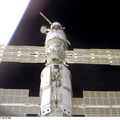
WIKIARCHIVES.SPACE
The Human Spaceflight Archive

Information
- Taken in
- Space
- Autor
- NASA
- Kirjeldus
- One of the STS-106 crew members on board the Space Shuttle Atlantis used a handheld 70mm camera to photograph this image of Cape Cod and parts of Massachusetts. Partial sun glint highlights the coastline and brings out subtle details in the waters around Massachusetts. The maximum advance of an ice sheet 23,000 years ago is marked by the unique shape of Cape Cod and by the islands of Nantucket and Martha's Vineyard. Rocks and debris left at the edges of the ice fronts made parts of the landscape slightly higher and more resistant to erosion. Glacial retreat and sea level rise covered the lower ground and gave us the more modern coastline that we are familiar with. The city of New Bedford can be located near the coast and just below the circular lakes of Long Pond, Great Quiittacas Pond, and Assawompset Pond.
- Created on
- Albumid
- US SPACE PROGRAM / SPACE SHUTTLE / MISSIONS / STS-106 / Mission Photos (Edited)
- Source link
- https://www.flickr.com/photos/nasa2explore/albums/72157634802388799/
- Külastust
- 70
- Hinnanguskoor
- hindamata
- Hinda seda fotot
- License
- CC BY-NC
- Modified by WikiArchives
- No (original)
- Allalaadimised
- 2
Toob teieni Piwigo






















































































































